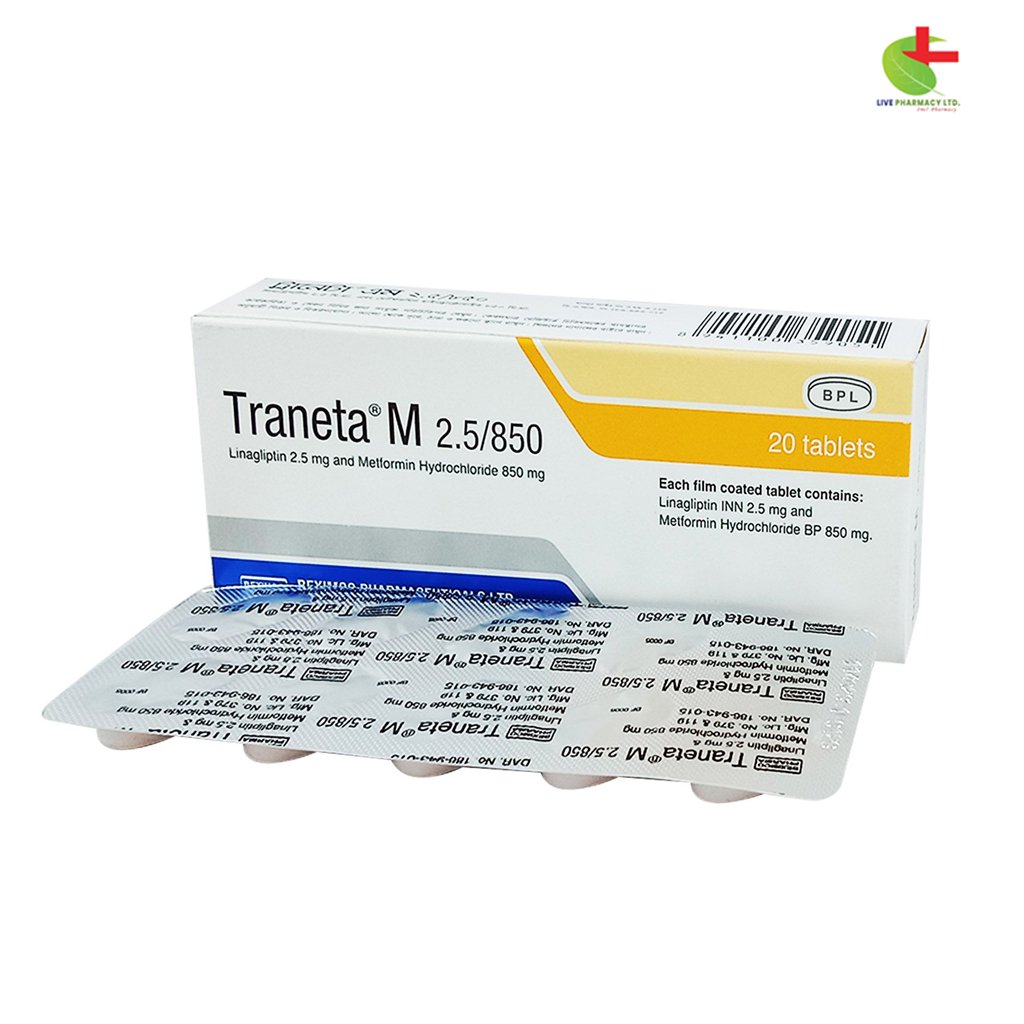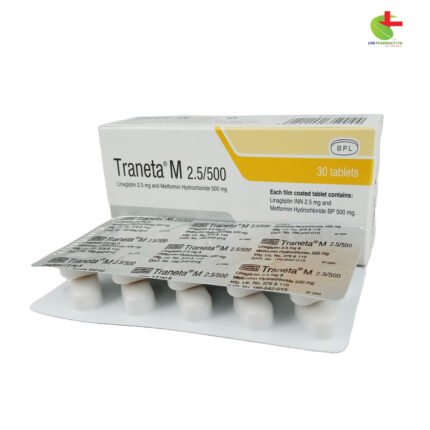Traneta M 850
150.00৳ Strip
- Traneta combines linagliptin and metformin hydrochloride to manage type 2 diabetes mellitus, improving glycemic control when used with diet and exercise.
- Linagliptin enhances insulin release and reduces glucagon levels, while metformin lowers glucose production and absorption.
- Available as both immediate and extended-release tablets, it is tailored to individual patient needs with minimal risk of hypoglycemia.
- Traneta is contraindicated in renal impairment and during metabolic acidosis.
 Brand
Brand
|
Beximco Pharmaceuticals Ltd |
|---|---|
 Generics
Generics
|
Linagliptin + Metformin Hydrochloride |
 Type
Type
|
Tablet |
Indications
Traneta is prescribed as an adjunct to diet and exercise for improving glycemic control in adults with type 2 diabetes mellitus. It is used:
- As Monotherapy: For patients who cannot achieve adequate blood sugar control with diet and exercise alone and are unable to tolerate metformin or have contraindications due to renal issues.
- As Combination Therapy: Alongside metformin for cases where diet, exercise, and metformin alone are insufficient. It can also be combined with a sulphonylurea for additional glycemic control when dual therapy does not suffice.
Pharmacology
Traneta combines linagliptin, a DPP-4 (dipeptidyl peptidase-4) inhibitor, with metformin hydrochloride to enhance blood sugar management in type 2 diabetes. Linagliptin works by blocking DPP-4, which increases the levels of incretin hormones GLP-1 (glucagon-like peptide-1) and GIP (glucose-dependent insulinotropic polypeptide). This mechanism promotes insulin release from pancreatic beta cells and reduces glucagon secretion from pancreatic alpha cells. Metformin hydrochloride, a biguanide, decreases glucose production in the liver, reduces intestinal glucose absorption, and enhances insulin sensitivity without causing hypoglycemia.
Dosage & Administration
- Immediate Release Tablets: Start with 2.5 mg linagliptin and 500 mg metformin hydrochloride twice daily. Gradually increase to a maximum of 2.5 mg linagliptin and 1000 mg metformin hydrochloride twice daily with meals to minimize gastrointestinal side effects.
- Extended Release Tablets: Begin with 5 mg linagliptin and 1000 mg metformin hydrochloride once daily with a meal. Adjust dosage based on patient needs, with a maximum of 5 mg linagliptin and 2000 mg metformin hydrochloride daily.
Interactions
Traneta may interact with cationic drugs that are excreted via renal tubular secretion. Use caution with carbonic anhydrase inhibitors and P-glycoprotein or CYP3A4 enzyme inducers. Monitor blood sugar closely when using drugs that affect glycemic control.
Contraindications
Traneta is contraindicated in patients with renal impairment, acute or chronic metabolic acidosis, and those with hypersensitivity to linagliptin or metformin hydrochloride.
Side Effects
Common side effects include nasopharyngitis and diarrhea. Hypoglycemia may occur, especially with sulfonylureas.
Pregnancy & Lactation
Category B for pregnancy. Use during pregnancy only if necessary, and caution is advised during lactation due to limited data on excretion in breast milk.
Precautions & Warnings
Monitor for lactic acidosis symptoms and pancreatitis. Discontinue use before major surgery or radiologic procedures with contrast dye. Monitor Vitamin B12 levels annually due to potential decreases.
Overdose Effects
For overdoses, supportive care is essential. Metformin hydrochloride is dialyzable, but linagliptin is not significantly removed by dialysis.
Therapeutic Class
Combination Oral Hypoglycemic Agents
Storage Conditions
Store below 30°C, away from light and moisture. Keep out of reach of children.













Reviews
There are no reviews yet.